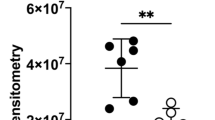Abstract
Much of the specification for the basic embryonic body plan is the result of a hierarchy of developmental decisions at different developmental times. The extracellular matrix (ECM) appears to be a very dynamic structure during embryogenesis. One of the mesenchymal ECM proteins, tenascin, is reported to be transiently expressed during embryonic tissue development, and is absent or much reduced in most fully developed organs. The respiratory system is an outgrowth of the ventral wall of the foregut, and the epithelium of the larynx, trachea, bronchi and alveoli is of endodermal origin. The cartilaginous and muscular components are of mesodermal origin. The aim of this study was to investigate the role of tenascin-C (TNC) in the developing human lung, during the pseudoglandular, canalicular and saccular stage of lung maturation. Formalin-fixed, paraffin-embedded tissue from the lungs of 30 embryos (10 corresponding to the 10th to the 16th gestational week (pseudoglandular stage), 10 to the 17th to the 23rd gestational week (canalicular stage), and 10 to the 24th to the 27th gestational week (saccular stage), were investigated by conventional histology and immunohistology for the expression levels of TNC. The changes observed in the distribution patterns suggest that during embryogenesis, the rate of tenascin synthesis changes significantly. During the pseudoglandular stage, the density of cells expressing TNC was higher in the condensing mesenchyme surrounding the epithelial glands than in the epithelial cells, whereas the inverse result was observed during the canalicular stage. During the saccular stage the pattern of immunoreactivity with TNC was lower than those of the pseudoglandular and canalicular stage, either in epithelial or mesenchymal cells, but it was highly expressed in the basement membranes. This restricted spatiotemporal distribution suggests that tenascin has a key role (1) in mesenchymal tissue remodeling during the pseudoglandular stage, a period that describes the development of the complete bronchial tree and (2) on the epithelial cell shape and function during the canalicular stage, a period that describes the formation of pneumocytes type I and pneumocytes type II. The later, will produce the surfactant, a phospholipid-rich fluid capable of lowering surface tension at the air–alveolar interface. During the saccular stage, tenascin was present mainly in the basement membranes surrounding the acinar and vascular structures, indicating a supporting and mechanical role.





Similar content being viewed by others
References
(1995) Gray’s anatomy, 38th edn. Churchill Livingstone, New York, p 179
Chiquet-Ehrismann R, Mackie EJ, Pearson CA, Sakakura T (1986) Tenascin: an extracellular matrix protein involved in tissue interactions during fetal development and oncogenesis. Cell 47(1):131–139
Orend G, Chiquet-Ehrismann R (2006) Tenascin-C induced signaling in cancer. Cancer Lett 244(2):143–163
Ishii K, Imanaka-Yoshida K, Yoshida T, Sugimura Y (2008) Role of stromal tenascin-C in mouse prostatic development and epithelial cell differentiation. Dev Biol 324(2):310–319
Chiquet-Ehrismann R, Chiquet M (2003) Tenascins: regulation and putative functions during pathological stress. J Pathol 200(4):488–499
Chiquet-Ehrismann R (1995) Tenascins, a growing family of extracellular matrix proteins. Experientia 51(9–10):853–862
Jones PL, Jones FS (2000) Tenascin-C in development and disease: gene regulation and cell function. Matrix Biol 19(7):581–596
Sternberger LA (1974) Immunocytochemistry. Prentice-Hall, Englewood Cliffs, pp 129–171
Mackie EJ, Thesleff I, Chiquet-Ehrismann R (1987) Tenascin is associated with chondrogenic and osteogenic differentiation in vivo and promotes chondrogenesis in vitro. J Cell Biol 105:2569–2579
Mackie EJ, Chiquet-Ehrismann R, Pearson CA et al (1981) Tenascin is a stromal marker for epithelial malignancy in the mammary gland. Proc Natl Acad Sci USA 84:4621–4625
Thesleff I, Kantomaa T, Mackie EJ et al (1988) Immunohistochemical localization of the matrix glycoprotein tenascin in the skull of the growing rat. Arch Oral Biol 33:383–390
Ekblom P, Aufderheide E (1989) Stimulation of tenascin expression in mesenchyme by epithelial–mesenchymal interactions. Int J Dev Biol 33:71–79
Engel J (1989) EGF-like domains in extracellular matrix proteins: localized signals for growth and differentiation? FEBS Lett 251:1–7
Koukoulis GK, Gould VE, Bhattacharyya A, Gould JE, Howeedy AA, Virtanen I (1991) Tenascin in normal, reactive, hyperplastic, and neoplastic tissues; biologic and pathologic implications. Hum Pathol 22(7):636–643
Acknowledgments
The authors would like to thank the midwives of the department of Obstetrics and Gynecology, Democritus University of Thrace, for supplying us with placentas and embryos. The skillful technical assistance of Irene Apostolou is gratefully acknowledged.
Conflict of interest statement
The authors declare that they have no conflict of interest related to the publication of this manuscript
Author information
Authors and Affiliations
Corresponding author
Rights and permissions
About this article
Cite this article
Lambropoulou, M., Limberis, V., Koutlaki, N. et al. Differential expression of tenascin-C in the developing human lung: an immunohistochemical study. Clin Exp Med 9, 333–338 (2009). https://doi.org/10.1007/s10238-009-0057-x
Received:
Accepted:
Published:
Issue Date:
DOI: https://doi.org/10.1007/s10238-009-0057-x




